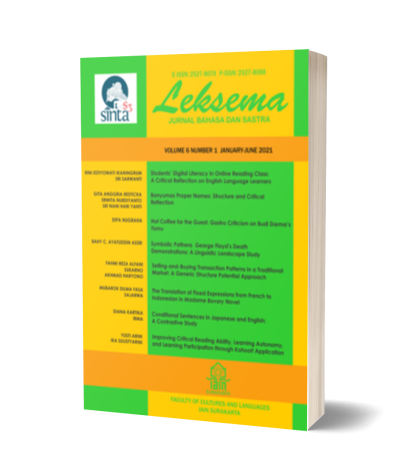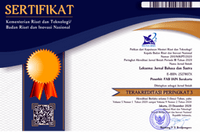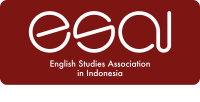TRANSLATION OF WORDS REPRESENTING THE AUTISTIC CHARACTER IN FLOWERS FOR ALGERNON NOVEL
DOI:
https://doi.org/10.22515/ljbs.v3i1.1204Keywords:
autism, translation techniques, errors, charactersAbstract
This study was aimed at analyzing the Indonesian translation of spelling, punctuation, and grammatical errors made by autistic character in Flower for Algernon novel. It also analyzes  translation techniques, methods, ideology, qualities of the translation. The method applied was descriptive-qualitative with the data in the form of translated words and phrases indicating spelling, punctuation and grammatical errors made by the autistic character. The primary data sources were Flower for Algernon novel along with its translation version in Indonesian. Meanwhile, the secondary data sources were informants who gave information on the accuracy, acceptability, and readability of translation. The process of collecting data used documentation, questionnaire distribution, and focus group discussion (FGD) technique whereas the sampling technique applied is purposive sampling. The findings of this research show that there are 309 data of words containing spelling, punctuation and grammatical errors. Four translation techniques are used by translator namely graphology normalizations, established equivalent, compensation, and deletion. The translation method used tends to be established equivalent with domestication ideology. The translation of words with errors by graphology normalization techniques produced accurate translations with decreases in acceptability. This is because the translator removes the autism markers from the source language to the target language.
Downloads
References
Akhadiah. 1990. Pembinaan Kemampuan Menulis Bahasa Indonesia. Jakarta: Erlangga
Bailey, Eileen. 2011. Asperger Syndrome. Matrix Parent Network and Resource Center. autism-help.org
Bastian, Amy. 2007. “Autism and Motor Skills: A Matter of White Matter?†Journal of Neurology, 47(4): 448-460.
Brann, B. 1997. The Brann Analysis Grid for Spelling. Australia: PJ Developments
Cantwell, DP, L Baker & RE Mattison. 1979. “The Prevalence of Psychiatric Disorder in Children with Speech and Language Disorder: An Epidiomologic Studyâ€. Journal of The American Academy of Child Psychiatry, 18: 450-461.
Catford, JC. 1965. A Linguistic Theory of Translation. Oxford: Oxford University Press
Chaer, Abdul. 2009. Psikolinguistik: Kajian Teoritik. Jakarta: Rineka Cipta.
Christie, Phil. 2009. Langkah Awal Berinteraksi Dengan Anak Autis. Jakarta: Gramedia Pustaka Utama
Cook, Vivian. 1999. Teaching Spelling. http://privatewww.essex.ac.uk/~vcook/OBS2O.html
Cook, Vivian. 2014. The English Writing System. New York: Taylor & Francis
Fay, L. 1971. “Reading and Spelling: How Are They Related?†.ERIC Document Reproduction Service No. ED059009
Flood, A. 2014. Flowers for Algernon’s Sad, Sweet Genius. https://www.theguardian. com/books/booksblog/2014/jun18/flowers-for-algernon-genius-daniel-keyes) (Accessed November 5, 2017)
Ida, F. 2006. English Spelling in Swedish Secondary School: Students’ Attitudes and Performance. Stockholm: Karlstads University
Kanner, L. 1968. “Autistic Disturbances of Affective Contactâ€. Nerv Child 2: 217- 50. Reprint: Acta Paedopsychiatry, 35 (4): 100-36
Larson, Mildred L. 1998. Meaning-based Translation: A Guide to Cross Language Equivalence. Lanham: University Press of America
Malmkjaer, K. 2005. Linguistics and the Language of Translation. Edinburgh: Edinburgh University Press Ltd.
Molina, L & Albir, AH. 2002. Translation Techniques Revisited: A Dynamic and Functionalist Approach. Meta: Translators’ Journal, XLVII (4)
Moseley, D. 1993. How Lack of Confidence in Spelling Affects Children’s Written Expression. Wellington: New Zealand Council for Educational Research
Nababan, MR. 2003. Teori Menerjemahkan Bahasa Inggris. Yogyakarta: Pustaka Pelajar
Nababan, MR. 2007. Aspek Genetik, Objektif, dan Afektif dalam Penelitian Penerjemahan. Surakarta: Universitas Sebelas Maret
Nababan, MR 2010. “Teknik-teknik Penerjemahan Teksâ€. National Seminar of Translation Proceeding. Madiun: UniversitasWidya Mandala
Nababan, MR, Ardiana. N, & Sumardiono. 2012. “Pengembangan Model Penilaian Kualitas Terjemahanâ€. Jurnal Kajian Linguistik dan Sastra, (24) 1: 39-57. Surakarta: Universitas Sebelas Maret.
Neubert, A. 2004. “Case Studies in Translation: The Study of Translation.†Across Language and Culture, 5 (1): 5-21
Newmark, Peter. 1981. Approaches to Translation. Oxford: Pergamon Press
Newmark, Peter. 1988. A Textbook of Translation. London: Prentice Hall
Nida, Eugene A & Taber, Charles R. 1974. The Theory and Practice of Translation. Leiden: United Bible Societies/EJ Brill
Nida, Eugene A & Taber, Charles R. 1982. The Theory and Practice of Translation. Leiden: EJ Brill
Nida, Eugene. 2000. Principles of Correspondence in Translation Studies Reader. London: Routledge
Nurdiantoro, Burhan. 1991. Teori Pengkajian Fiksi. Yogyakarta: Gadjah Mada University Press
Retnomurti, Ayu Bandu & Indiyah Imran. (…). The Equivalence and Shift in the English Translation of Indonesian Noun Phrases. Jakarta: Universitas Gunadarma
Santosa, Riyadi. 2017. Buku Metode Penelitian Kualitatif Kebahasaan. Surakarta:UNS Press.
Smedley, D. 1983. Teaching the Basic Skills: Spelling, Punctuation, and Grammar in Secondary English. London: Methuen
Spradley, James P. 2007. Metode Etnografi. Yogyakarta: Tiara Wacara.
Sterling, Bruce. 2016. Science Fiction, Literature and Performance. London: Encyclopedia Britannica Press
Sutopo, Anam. 2016. “Model Penilaian Kualitas Terjemahan Karya Sastraâ€. The 4th University Research Colloquium 2016. ISSN 2407-9189
Widdowson, Henry. 2004. “Text, Context, and Pretextâ€. International Journal of Applied Linguistic
Willett, L. 2003. Using Spelling Data to Improve Students Learning Outcomes: More than Just Numbers. Brisbane: Australia-Queensland Studies
Wilkinson, David. 2000. The Researcher’s Toolkit. London: Cambridge University
Wiratno, Tri. 2003. Analisis Bahasa dari Sudut Pandang Linguistik Sistemik Functional (Makalah). Surakarta: Universitas Sebelas Maret
Downloads
Published
Issue
Section
License
The copyright of the received article shall be assigned to the publisher of the journal. The intended copyright includes the right to publish the article in various forms (including reprints). The journal maintains the publishing rights to published articles.
In line with the license, the authors and users (readers or other researchers) are allowed to share and adapt the material only for non-commercial purposes. In addition, the material must be given appropriate credit, provided with a link to the license, and indicated if changes were made. If authors remix, transform or build upon the material, authors must distribute their contributions under the same license as the original.







